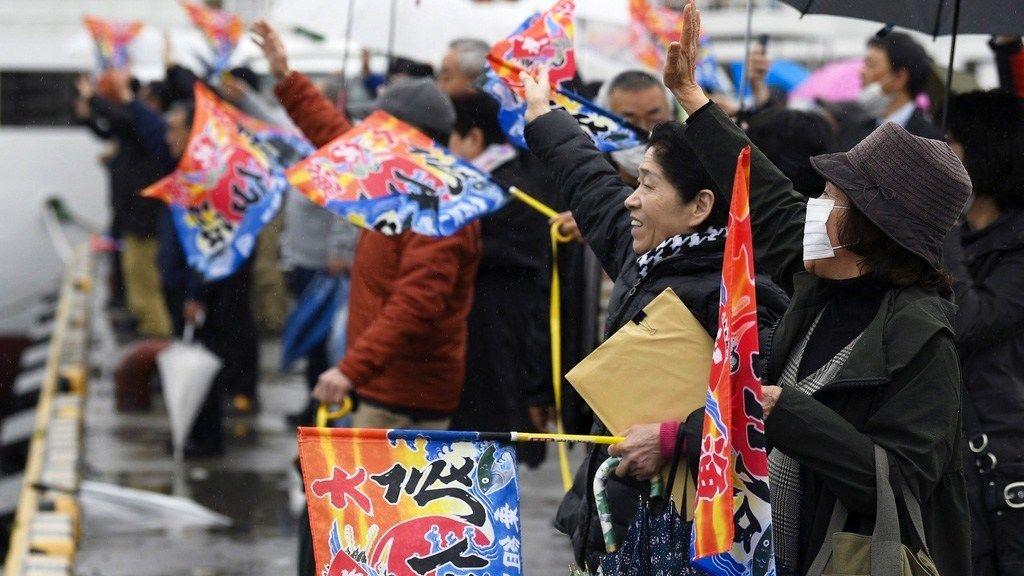
Kesennuma 10 Years after the Tsunami: Building a New Relationship with the Sea
Society- English
- 日本語
- 简体字
- 繁體字
- Français
- Español
- العربية
- Русский
Situated on a tsunami-prone stretch of coastline in Miyagi Prefecture, Kesennuma has coexisted with the sea and its perils for centuries. Well before the Great East Japan Earthquake of 2011, the municipal government had taken numerous steps to protect the community: educating citizens about tsunami hazards, drawing up evacuation maps, and conducting repeated disaster drills.
But no one anticipated an event on the order of that which occurred on March 11, 2011. Consequently, even after repeated warnings, many residents stayed put, feeling safe in the knowledge that they were outside the hazard zone. In a city of about 74,000, a total of 1,246 lives were lost. The decade since then has been a long and challenging exercise in building a new and sustainable relationship with the sea, on which the city’s economy and culture is founded.
A Lesson in Vigilance
The students and faculty of Kesennuma Kōyō High School all escaped with their lives, but the ruins of their old school building attest to the tsunami’s almost unimaginable force. The building has been preserved as an enduring reminder of the need for vigilance in the face of such destructive power.
On an exterior wall, four stories up, one can clearly see the ragged wound left by a refrigerating plant that crashed into the school building after being swept up by the tsunami. An overturned car rests on the third floor, where it was deposited by the torrent. Textbooks and teaching materials lie scattered amid the wreckage. Everything has been preserved just as the tsunami left it.
In the exhibition facilities built adjacent to the ruins, visitors can watch a video of Hashikami Junior High School’s graduation ceremony, held 10 days after the disaster in the school gymnasium, which was one of the evacuation sites. A member of the graduating class, which lost three students in the disaster, delivers a tearful eulogy: “It seems too high a price to pay to learn the value of a human life. But however trying our circumstances, it is our duty now to bear our lot without cursing heaven and help each other live on.”
Those who have chosen to live with the sea in the wake of the disaster are mindful of its fury. But they also remember its bounty and majesty.
At a memorial service held by the city of Kesennuma a year after the disaster, a third-year high school student spoke on behalf of the bereaved. She had lived under one roof with her parents, grandparents, and siblings until the tsunami took all seven, leaving her the sole survivor. “Even though the ocean has robbed me of so many people and memories I hold dear,” she said, “I still love the sea. I will always love the ageless sea where my family dwells.”
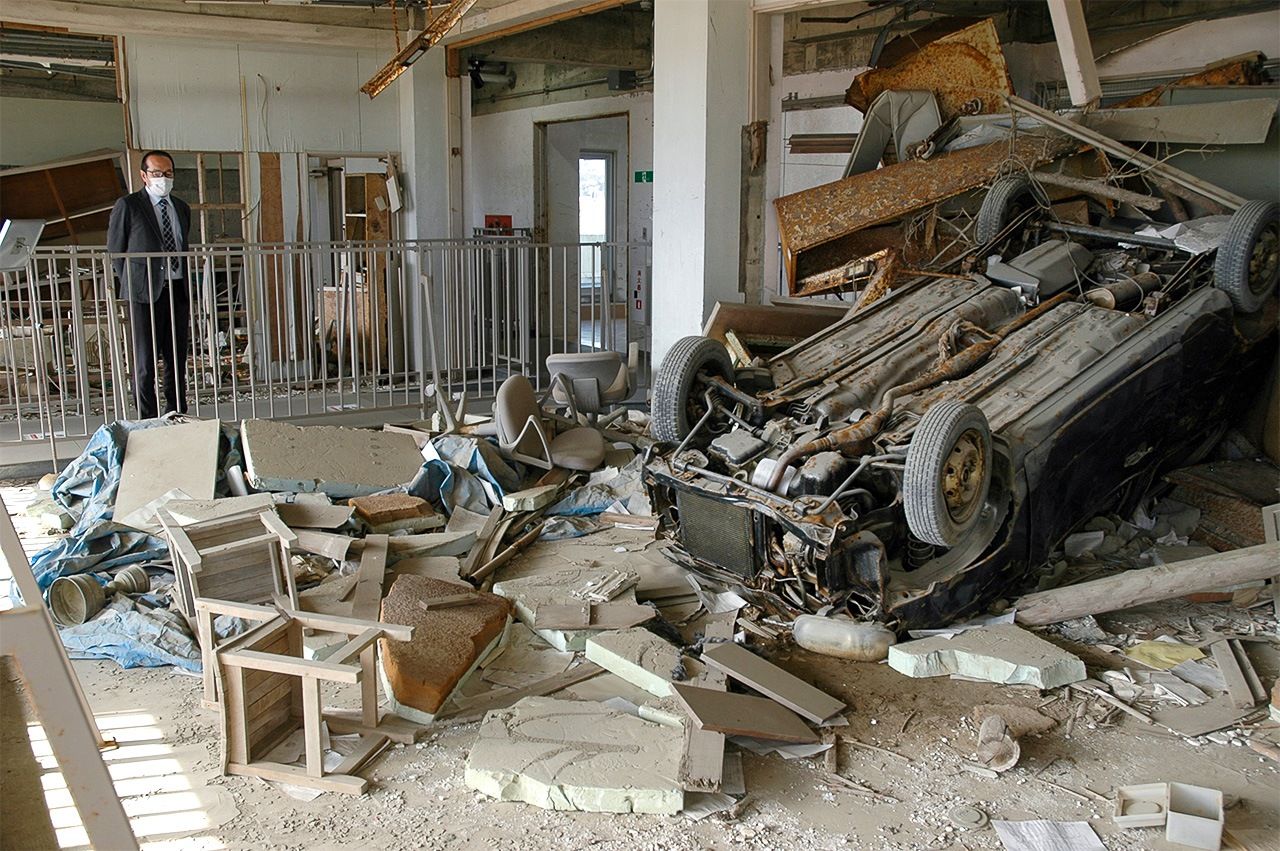
The ruins of the building that formerly housed Kesennuma Kōyō High School have been preserved as a memorial. The overturned car on the third floor testifies to the horrific force of the tsunami.
Kesennuma’s Choice
In the wake of the March 2011 disaster, Kesennuma embraced a wide range of measures and policies designed to protect the area and its citizens from a comparable disaster in the future. But those whose homes had been damaged or destroyed by the tsunami still faced a difficult choice: whether to continue living in close proximity to the sea or to relocate.
Of the approximately 9,000 households affected by the tsunami, about 30% initially elected to relocate to new, disaster-proof housing being built for that purpose—10% to private developments for neighborhood relocation, and another 20% to public housing for disaster victims. About 140 families signed up to buy homes in the coastal neighborhood that was slated for land readjustment,(*1) including artificial land elevation. The remainder opted to repair their damaged houses or find a new place to live independently. Ultimately, many moved inland.
It was no easy matter securing land for residential development in sections of the city deemed safe from future disasters. All the large, shovel-ready tracts inland had been put to use for temporary housing, which had to take priority. The remaining sites required large-scale earthworks and construction of access roads. Even after site preparation began, there were numerous delays, including issues finding places to deposit excavated soil and rock.
It was 2017 before all the public housing was completed, and the last of the private developments was not finished until 2019. By that time, the displaced families had aged, and households had shrunk. A considerable number of those who had initially signed up for a house in a private development ended up switching to public housing.
Setbacks in Coastal Reconstruction
These decisions had a major impact on the coastal district of Minami Kesennuma, which underwent massive land readjustment and redevelopment after the tsunami.
Wedged between Kesennuma Bay and the Ōkawa river, pre-tsunami Minami Kesennuma was a lively urban neighborhood populated by some 1,560 households, with a dense mixture of shops, fish processing plants, and private homes. In March 2011, the low-lying district was inundated by a tsunami five to seven meters high.
Under the city’s reconstruction plan, the entire area was to be built up some three meters, replotted, and redeveloped. That ambitious project was finally completed in September 2019. A large bookstore, drugstore, clinic, and other businesses opened in rapid succession. As of the end of 2020, some 501 households had resettled the district, but a full 344 of those were concentrated in the new public housing complex. As a result, much of the land lies vacant, notwithstanding the city’s efforts to help match up private landowners with businesses seeking to buy or rent. The neighborhood has yet to regain its former vitality.
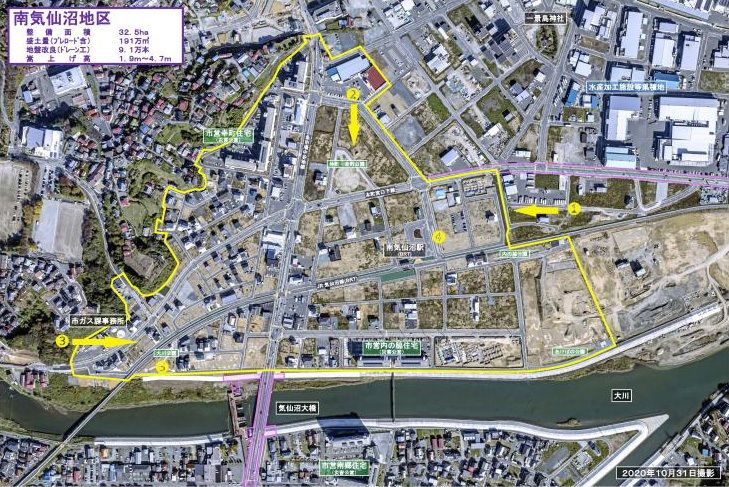
An aerial view of Minami Kesennuma, October 31, 2020.
As part of the readjustment process, some of the land formerly occupied by residents was devoted to a public plaza and a “disaster prevention park” or converted into an industrial zone. But the main reason for the drop in the residential population was that many households simply chose not to move back. Not a few had misgivings about returning to the same area that had been inundated by the tsunami in 2011, even after it had been built up three meters. The prolonged development process also took its toll, as mentioned above.
All told, the district’s redevelopment took about two and a half years longer than originally planned. By the time the project was underway, some of the locals had already completed repairs on their damaged homes—which now needed to be demolished to make way for land-raising work. That meant securing temporary accommodations for those inhabitants, some of whom had only recently moved out of temporary housing. The relocation of water pipelines and other underground utilities was also time consuming.
Earth moving was another major problem. Altogether, the city’s plans required about 13 million cubic meters of earth to elevate coastal areas and build seawalls and levees, whereas excavation at development sites inland generated only about 10 million cubic meters; the remainder had to be bought. Moreover, since the inland developments were proceeding faster than the coastal projects, the earth and rock excavated from the high ground could not simply be transferred to the coast. Finding acceptable sites to deposit the earth temporarily was not easy.
A large dump truck can carry about 5 or 6 cubic meters at a time, and there were 10 million cubic meters to be transported. In the early stages of construction, the many dump trucks and other construction vehicles created massive traffic jams.
In the end, notwithstanding Kesennuma’s vision of “living with the sea,” the number of coastal dwellers fell sharply. Before the 2011 tsunami, the sea breeze had been a constant, familiar presence in our lives. We never realized how blessed we were.
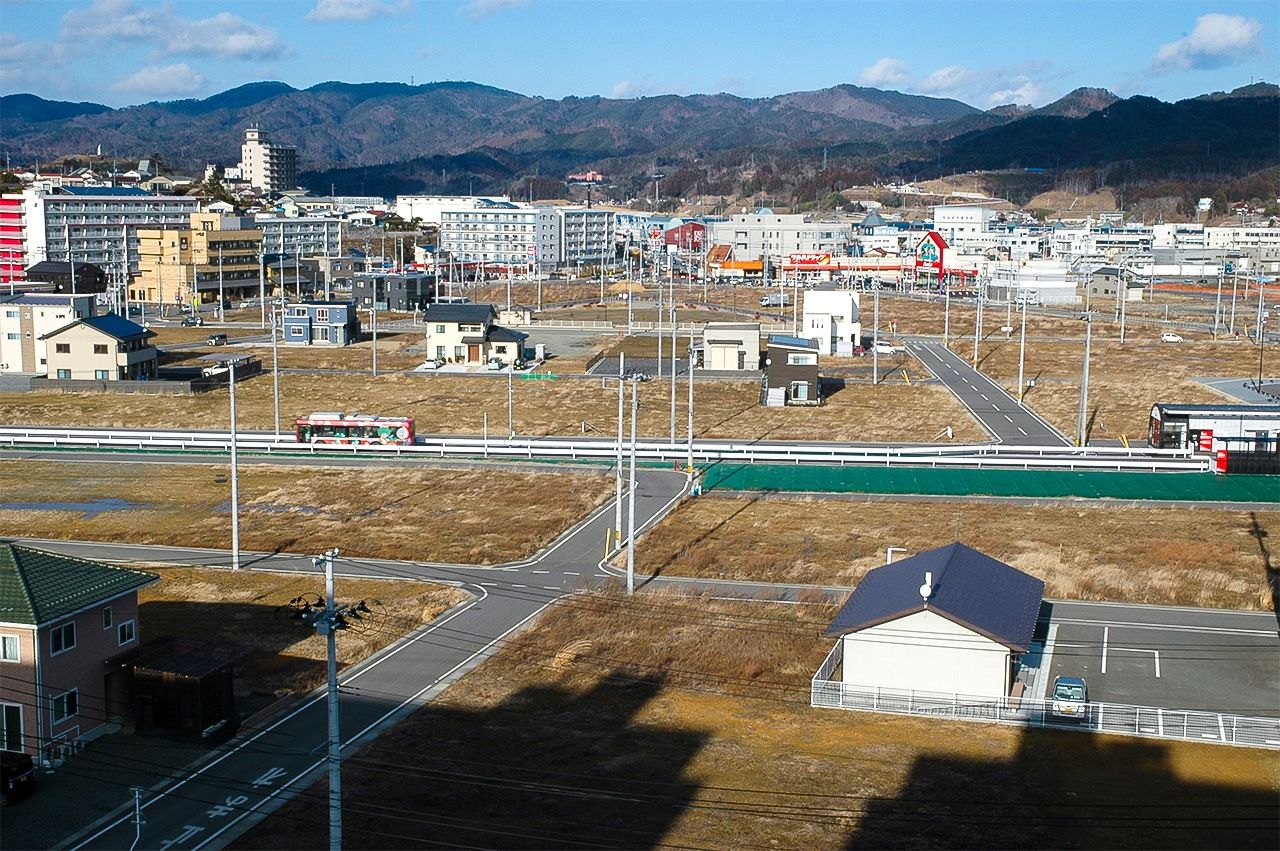
Vacant lots give the newly redeveloped district of Minami Kesennuma a deserted look.
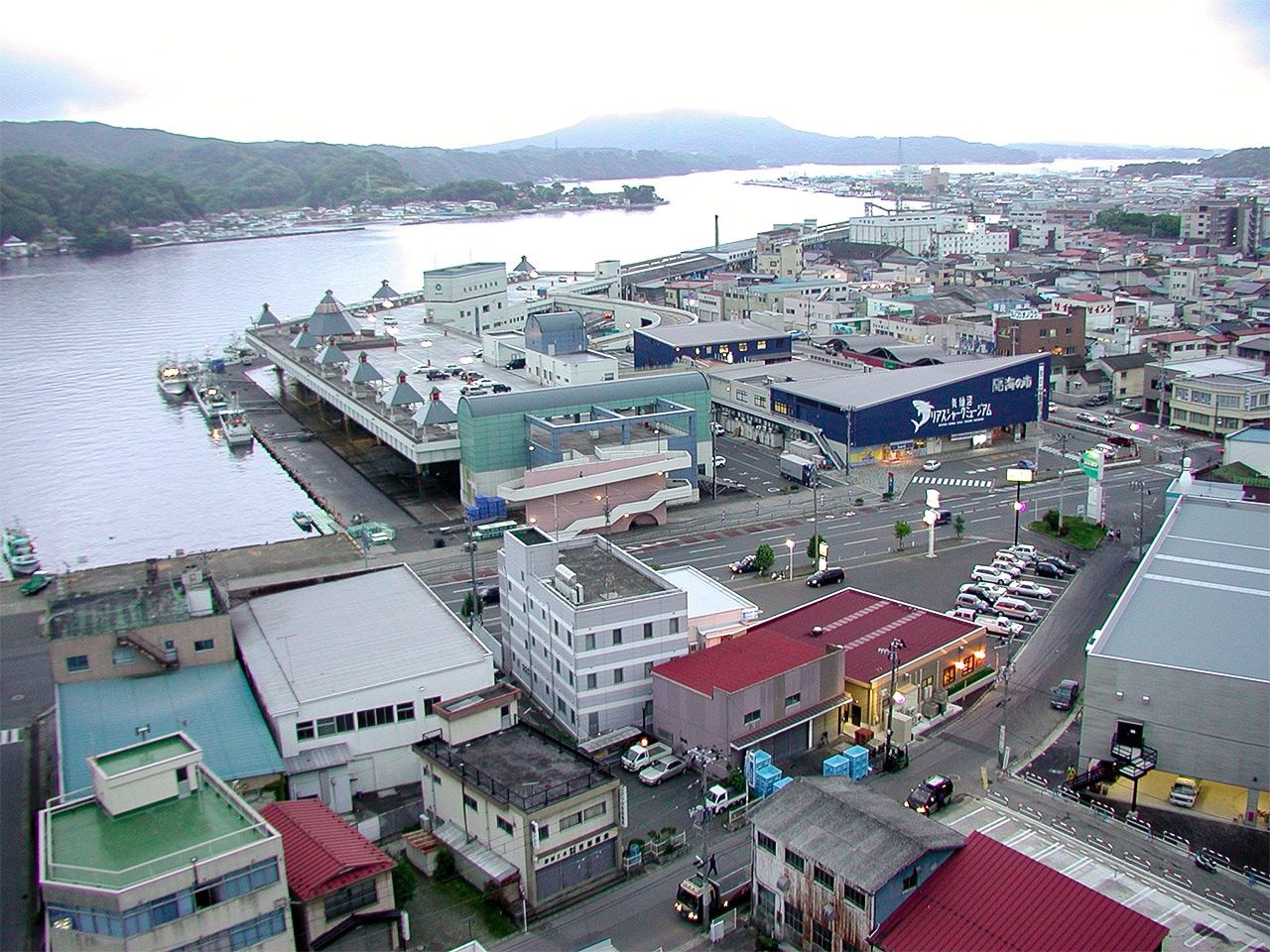
The waterfront of Minami Kesennuma before the tsunami.
Reconstruction and Beyond
It has been a productive but exhausting 10 years. In year 1, we had our hands full just building temporary housing, clearing debris, and otherwise securing a basic living environment for our citizens. It was not until year 2 that we could start thinking about rebuilding livelihoods and communities. Year 4 saw the completion of the first replacement housing units and a partial return to normalcy, allowing us to grapple with the issue of seawalls and other forms of coastal protection. In year 6, we set to work rebuilding our tourist facilities and community center. From then on, the reconstruction process proceeded apace, with the completion of the new municipal hospital, fish market, and shopping district and the opening of the Sanriku Expressway and Kesennuma Ōshima Ōhashi bridge. More good news came with the decision by public broadcaster NHK to use Kesennuma as the main location for the latest installment of its morning drama series, Okaeri Mone, scheduled to begin airing in May 2021.
The city of Kesennuma and its citizens are proactive and enterprising. We have created a new tourism authority, incorporating lessons learned from the Swiss city of Zermatt; instituted incentives for new ventures by young residents and transplants; built a shipyard for a new shipbuilder formed by the merger of several small competitors; and completed a long-awaited “park golf” course. We have also succeeded in attracting a beer brewer and other employers to our city. Powering this “creative reconstruction” are the many longtime residents who threw themselves into community affairs in the aftermath of the tsunami, as well as a group of energetic young transplants, many of whom first came to Kesennuma as volunteers.
The city of Kesennuma alone has spent more than ¥1 trillion on reconstruction, and it has much to show for that investment. But long-term problems loom. The city’s population, which stood at 74,000 in February 2011, had fallen to 61,000 as of the end of January 2021. Demographic aging and the exodus of young residents are the main culprits. Amid the bustle of redevelopment, local public schools and daycare centers have been quietly merging. The National Institute of Population and Social Security Research projects that the city’s population will have dwindled to 33,000 by 2045.
Meanwhile, falling catches threaten the fishing and marine-products industries on which the local economy depends. Fear competes with hope in the hearts of our citizens.
The numerous municipal mergers and dissolutions that took place from the late 1990s on were intended to streamline local administration in regions grappling with depopulation. Since then, many municipalities in the region have been busy downsizing government to adapt to the new era. But the tsunami-struck communities have had their hands full with reconstruction. Now that the decade allocated to that task is drawing to an end, they are facing this new challenge and have little energy left for the task.
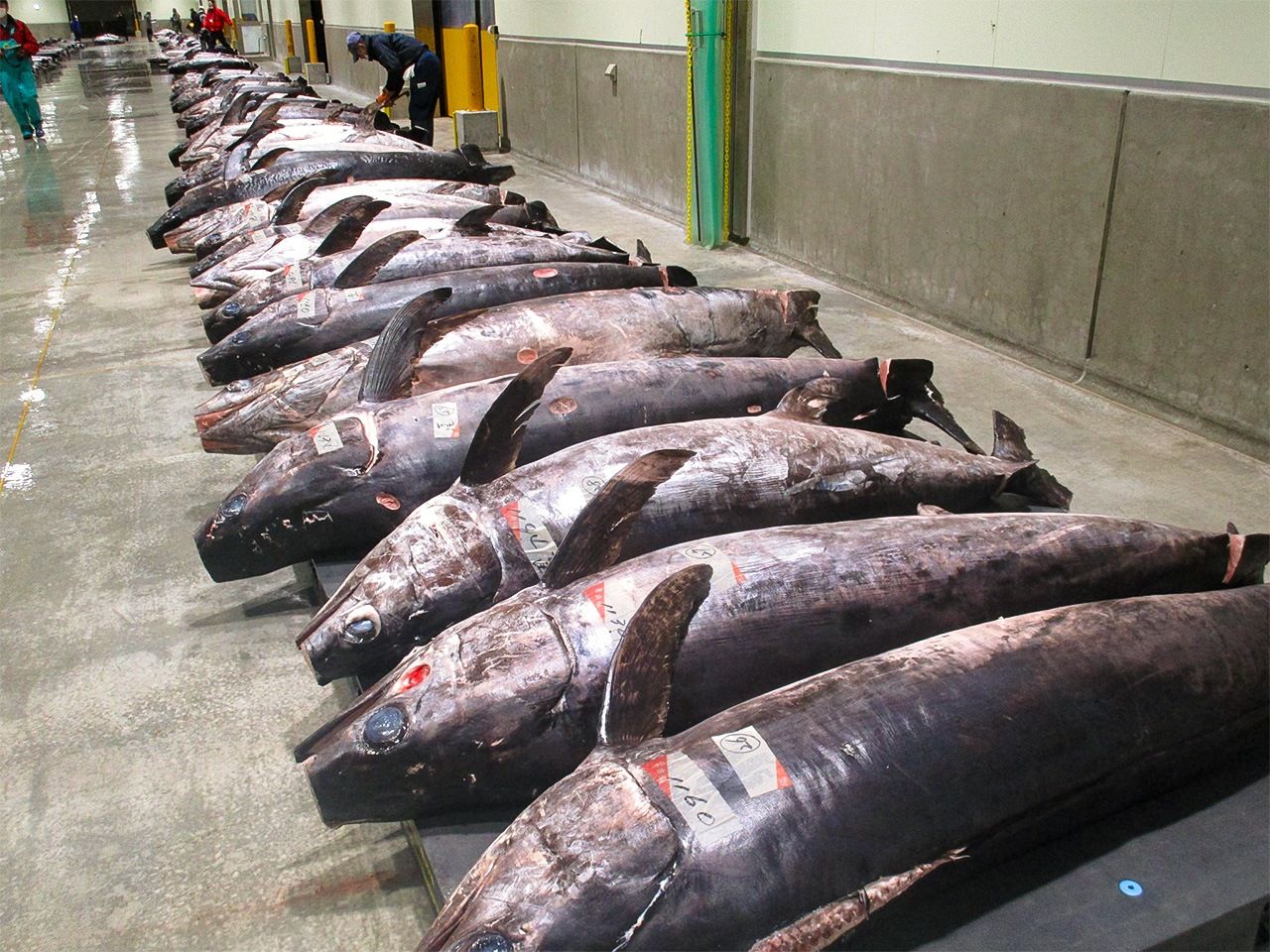
Swordfish at the Kesennuma fish market. Kesennuma boasts more commercial landings of swordfish—some weighing more than 300 kilos—than any other port in Japan.
Kesennuma and the Pandemic
Year 10 of reconstruction did not go quite as envisioned.
We had spoken of holding a series of events to commemorate the tenth anniversary and to thank everyone who had contributed to Kesennuma’s reconstruction. We envisioned a joyful reunion of former volunteer workers and seconded staff from around the region. We pictured the city’s newly rebuilt shops and restaurants humming with visitors. We even fretted that—between the tenth anniversary events, the opening of the Sanriku Expressway, and publicity surrounding the new NHK morning drama—we might be overwhelmed by an influx of tourists.
Of course, the impact of COVID-19 has been felt all around the world. What has made it especially difficult for Kesennuma is the timing. People were just getting back on their feet. For many home and business owners, loan repayments were coming due after a five-year deferral.
Now some survivors have reached the breaking point. Amid the pain of losing loved ones, homes, and the seaside town they once knew, they have sustained themselves through close contact with friends, associates, and volunteers. Social distancing has robbed them of that comfort and sustenance.
For most of us, however, the experience of recovering and rebuilding from the disaster of 2011 has been a lesson in hope and resilience. It has reminded us that the night always gives way to the dawn. We have learned how important it is to help and support one another. We also know how difficult it can be to ensure safety while preserving people’s livelihood and way of life.
The pandemic, too, will pass. When it does, I invite you all to visit the new Kesennuma and see for yourself what it really means to live with the sea.
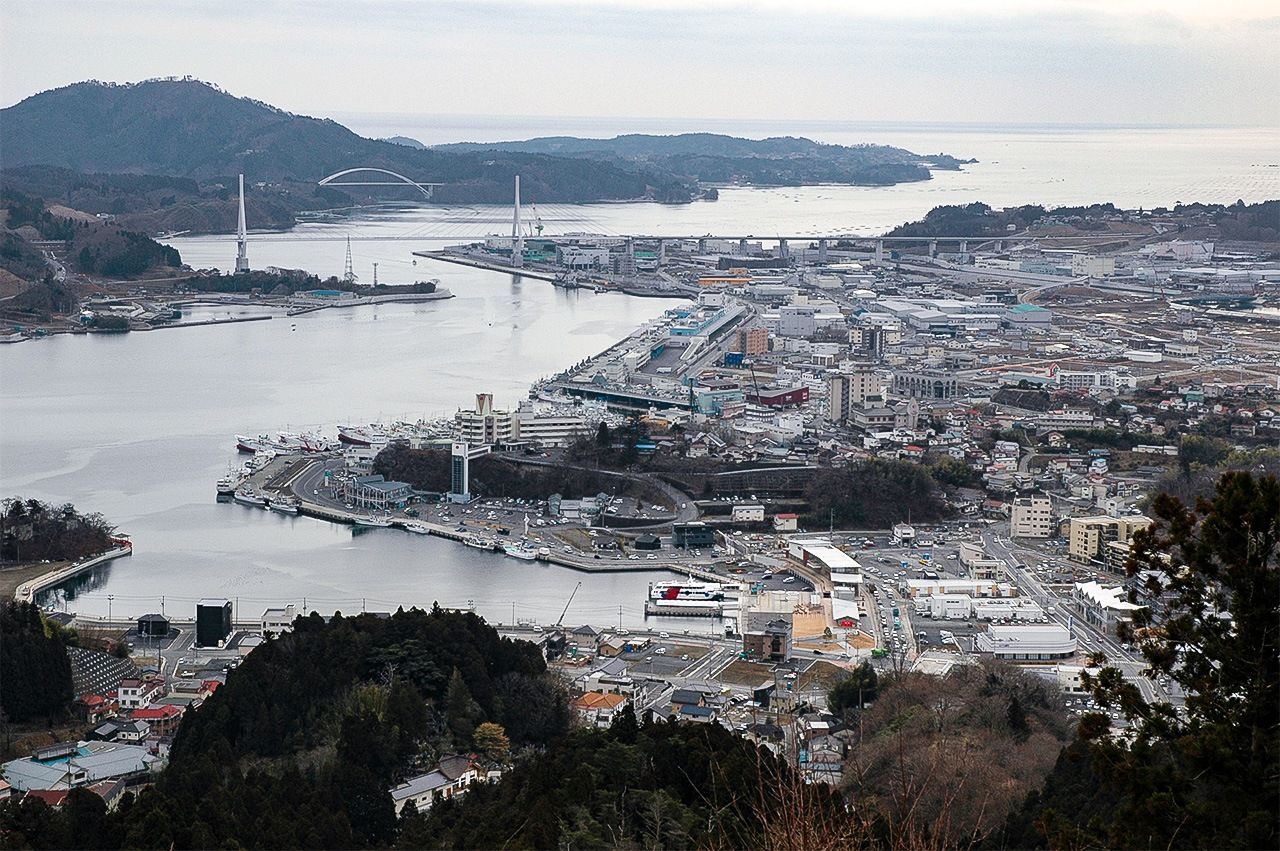
Reconstruction work around Kesennuma Bay is nearing completion, as seen from Mount Anba.
(Originally written in Japanese. Banner photo: The people of Kesennuma see the local fishing fleet off with prayers and colorful flags in one of the coastal community’s annual ceremonies, March 2020. © Kyōdō.)
(*1) ^ An approach to large-scale reconstruction of urban or residential land based on majority agreement of the local landowners with a view to preserving existing ownership rights and community cohesion.
disaster tsunami Great East Japan Earthquake recovery Kesennuma